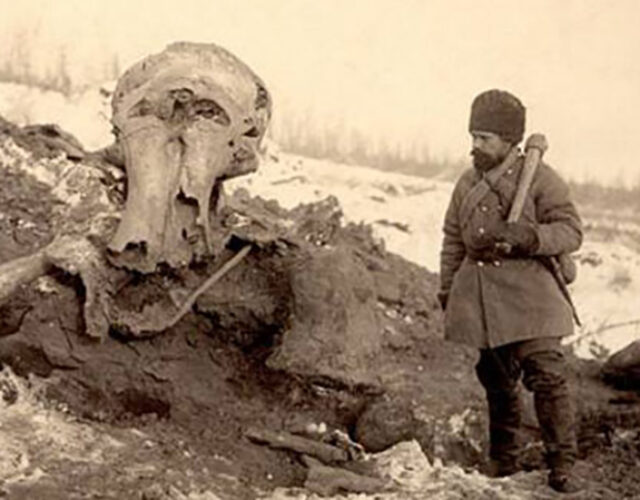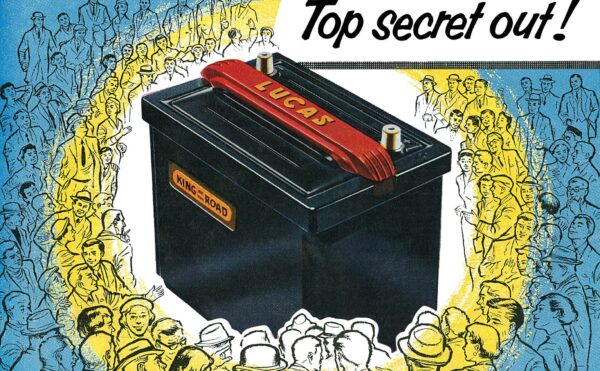In 1901, after a hunting dog had sniffed out strange prey along the Berezovka River in Siberia, paleontologist Eugene Pfizenmayer set out on an expedition to identify and retrieve the body. After a four-month journey deep into the Arctic, Pfizenmayer reached his prize: a woolly mammoth half buried in ice and still partially covered in flesh and tufts of brown hair. Pfizenmayer later wrote,
Woolly mammoths died out about 10,000 years ago (though some survived until more recent times on islands in the Arctic). Since Pfizenmayer’s original specimen was unearthed, dozens of frozen mammoth remains have been found, mostly in Siberia. Some of the carcasses are more than 60,000 years old. From the best-preserved specimens scientists learned that mammoths had large humps on their backs to store fat, multiple layers of thick hair, and red blood cells that might have carried more oxygen than those in modern elephants. Such well-preserved mammoth cells, combined with recent breakthroughs in cloning technology, have sparked the imagination of some scientists and members of the public: would it be possible to clone ancient mammoths from their frozen remains and so bring a species back from extinction?
In the past 20 years two high-profile cases have given support to this idea. Dolly the Sheep was born in 1996 after being cloned through nuclear transfer. In this technique native DNA is extracted from an egg’s nucleus and replaced with the DNA of the animal to be cloned. The egg is then placed inside the uterus of a surrogate mother. The embryo and host must belong to closely related species to avoid rejection.
Another cloning experiment managed to bring an extinct species back to life, albeit briefly. In 2009 a team of scientists in Spain used nuclear transfer to clone the last Pyrenean ibex, which had died in 2000. (Cells were harvested from the ibex and frozen shortly before its death.) After implanting 57 ibexes and goat-ibex hybrids with eggs containing Pyrenean ibex DNA over a six-year period, a fetus was brought to term. Its lungs were malformed, and the animal suffocated within 10 minutes. But for those few moments the Pyrenean ibex was no longer extinct, giving scientists hope that the process might work on long-dead species.
Since these experiments many other animals have been cloned, including horses, cows, dogs, and cats. But successfully cloning a long-extinct pachyderm would be a lot harder than cloning a golden retriever. Researchers used living tissue when cloning Dolly and the Pyrenean ibex; a mammoth cell with a complete set of DNA is unlikely to be discovered. Scientists will have to rebuild a complete mammoth genome from the frozen bits and pieces of DNA scavenged from long-dead beasts. A group of researchers at Pennsylvania State University have sequenced roughly 70% of the mammoth genome by combining scraps of DNA from different frozen mammoths, but the technology to turn this partial blueprint into a full one does not yet exist.
Even if scientists could create a full mammoth genome, they would have to grow the creature inside a living elephant, likely using nuclear transfer. This process has it own pitfalls: we have a limited understanding of elephant reproduction, and no one has successfully harvested an egg from a female elephant.
Alternative methods of re-creating the woolly mammoth have been suggested. One proposal begins with splicing genes unique to mammoths into a strand of elephant DNA. Another method would be to “back-breed” elephants. Elephants are closely related to mammoths; selective breeding for mammothlike traits might lead to something that looks like a mammoth. But these processes would create only an approximation of a mammoth, not the real thing.
Whether or not cloning is feasible, the ethics of bringing extinct species back to life is an open debate. If we were to successfully clone an extinct species, would there be enough genetic diversity to create a healthy, sustainable population? Would the species only exist in zoos for our amusement, or would it be introduced to an evolving ecosystem with its own plants, predators, and diseases?
One man believes he has the perfect home for mammoths and that the animals could help turn heavily forested Siberia into a new version of the Pleistocene era’s grassy steppes. Sergey Zimov calls his project Pleistocene Park, and while it lacks now-extinct species, he is gradually reintroducing large animals, such as moose and horses (and potentially tigers), into northern Siberia. He theorizes that the presence of big animals will allow native grasses to flourish as they did during the days of the mammoth (think African savannah, but much colder).
Mammoths played a crucial role in prehistoric Siberia. They knocked down trees and cleared paths through forests, allowing sunlight to reach the ground and smaller plants and grasses to grow, which fed other herbivores. Zimov uses bulldozers to play the role of mammoths for now, but he would welcome the real thing if scientists ever clone them.
Pleistocene Siberia was colder and drier than modern Siberia. As the planet warmed at the end of the last major ice age, Siberia’s grassy steppe transformed into largely coniferous forests with little nutritional value for large mammals. Part of the reason Zimov thinks it possible to re-create a prehistoric ecosystem is because he believes that human hunting, not environmental changes, drove out the large mammals. There is no unanimously accepted theory to explain the extinctions of the Pleistocene era, but scientists blame a combination of factors, including climate change and to a much lesser extent human activity. A successful Pleistocene Park might show that the lack of large animals triggered the ecological shift as opposed to the other way around. Which raises another question: if humans caused an extinction, do we have an obligation to bring that species back?
A mass extinction caused by human activity is happening right now. Biologists estimate that pollution, poaching, and environmental destruction drives somewhere between 0.01% and 0.1% of Earth’s species to extinction each year. In response many environmentalists argue that instead of trying to resurrect extinct species we should focus on saving the species we have.
Beauty seems to play some role in deciding which species get protected (and potentially resurrected). It is easier to raise money and create public sympathy for a cuddly or woolly mammal than it is for a slimy frog. Yet amphibians are more sensitive to environmental change than many other types of organisms, and at least one-third of all amphibian species are in danger of extinction. Prioritizing the planet’s most endangered species regardless of appearance might be a better policy.
Still, a number of researchers have committed to cloning a woolly mammoth using DNA taken from frozen carcasses. Hwang Woo-suk of the Sooam Biotech Research Foundation is working with a group of Russian scientists at the North-Eastern Federal University in Yakutsk, Siberia. These researchers recovered a frozen mammoth containing what may be liquid blood. Will this research bring about the mammoth’s rebirth? It’s doubtful. Hwang was convicted of embezzling money from the South Korean government in 2009 and of fabricating results in 2004 when he claimed that he had cloned a human embryo.




